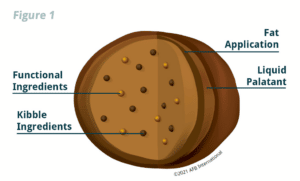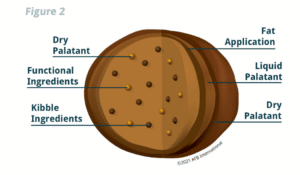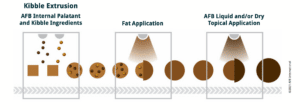OVERVIEW In dry pet food manufacturing, the standard palatant application sequence typically follows three steps: (i) fat spraying, (ii) liquid palatant spraying, (iii) dry palatant application. Most fats must be heated (30-40 °C) to remain liquid. Once the fat is applied, palatants are usually layered on top, as depicted in...

Applying Pet Food Palatants
Pet parents want their cats and dogs to enjoy the food they eat. In order to attract and sustain interest, the food must appeal to the pet’s senses of taste and smell. One key to producing high-performing diets that pets want to eat is the application of topical liquid or dry flavor systems known as palatants. This white paper reviews the recommended guidelines for applying these palatants.
LIQUID PALATANTS
Liquid palatants are delivered in bulk tankers or in an intermediate bulk container (IBC). Tankers are advised when large quantities are used; otherwise IBCs are recommended. IBC use also depends on the factory layout or use of multiple palatants. Commonly stored on site in agitated storage tanks, liquid palatants perform best when maintained between 70°F and 95°F.
Due to natural physical characteristics, liquid products may exhibit some separation. The separation will not have an effect on palatability and can be controlled by agitation just before use. When a tank is used to store the bulk delivery, the tank must contain an agitator to blend the product before use to achieve homogeneity. Mix the product just enough to keep it moving and to avoid inclusion of air. Too much air inclusion can cause foam which could affect the product quality.
Blending the product in the tank will also prevent potential formation of a water layer on top created by condensation when temperature differences occur. A watery layer will change the pH and preservative concentration causing a potential risk for mold and other bacteria to grow on top of the product. An agitator in the tank will also help prevent this watery layer.
Figure 1

To apply liquid palatants, suitable coating systems include drum coaters, batch coaters, screw coaters, augers or spinning disks. Set up the system to add the fat first, then the palatant. (Figure 1) Once complete, blend kibbles properly to be sure a homogeneous coating is reached and to allow the fat and palatant to fully absorb. Blending time depends on factory layout, required throughput and coater type. (Figure 3: Palatant Application Process)
For optimal kibble performance when applying a liquid palatant:
Keep air out of the palatant application process. Include baffles in mixing tanks and eliminate free-fall product return on recycle systems to help prevent fat from oxidizing, which can decrease palatability performance.
Avoid over-application. Carefully synchronize the kibble feed rate and the palatant application rate to prevent excessive application, which could increase moisture and lead to mold growth if not properly monitored during production. Retention time. After the fat and digest dosing, a certain retention time allows flavors and moisture to distribute homogeneously over the kibbles.
Choose the correct spray nozzle for your application. Two recommended nozzle types are flat spray pattern and full cone spray pattern. The right nozzle choice depends on coater type and setup. The size, or opening, of the nozzle depends on the amount of the liquid you want to apply. The nozzle should form very small droplets, not a mist or a pouring liquid.
Prevent overspray. Aim spray nozzles to avoid excessive buildup on the augur or coating drum, which could compromise pet food quality over time as fines will stick to the liquid creating lumps composed of materials from multiple batches.
Carefully position palatant and fat spray nozzles. Ensure no more than 10% overlap in palatant spray patterns to support consistent performance. Also strive for no overlap between the fat and palatant application.
DRY PALATANTS
Dry pet food palatants are packaged in standard dry bags or bulk bags.
Dry palatants are added after the fat or liquid palatant application. (Figure 2) The fat or liquid palatant acts as a tacking agent and is an integral part of the total palatability solution. Dry palatants are fed into the coating system using a loss-in-weight or a volumetric feeder. Pulse dosing should be avoided to obtain a homogeneous spreading of the powder. The hopper of the feeder should contain an agitator to avoid bridging of the powder which would disrupt an even powder supply. (Figure 3: Palatant Application Process)

For optimal kibble performance when applying a dry palatant:
Coat kibbles evenly. Discharge kibble onto a plate or splitter to facilitate continuous flow of the desired kibble quantity which will secure accurate palatant dosing.
Avoid impeded flow. The small size of the feeders often requires the use of vibrators or flow assist devices. Avoid palatant buildup on the coating system. Maintain the desired kibble level before applying dry palatant to avoid such buildup.
Figure 3: Palatant Application Process

Kibble Extrusion
AFB Internal Palatant AFB Liquid and/or Dry and Kibble Ingredients Fat Application Topical Application
Ensuring product performance for pet food manufacturers and their customers is our business. Contact our Global Sales team at www.afbinternational.com/contact for assistance with palatant application and your pet food.